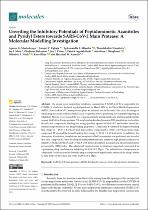| dc.contributor.author | Odugbemi, Adeshina I. | |
| dc.contributor.author | Mushebenge, Aganze G. | |
| dc.contributor.author | Ugbaja, Samuel C | |
| dc.date.accessioned | 2024-02-15T09:03:05Z | |
| dc.date.available | 2024-02-15T09:03:05Z | |
| dc.date.issued | 2023 | |
| dc.identifier.citation | Mushebenge, A.G., Ugbaja, S.C., Mtambo, S.E., Ntombela, T., Metu, J.I., Babayemi, O., Chima, J.I., Appiah-Kubi, P., Odugbemi, A.I., Ntuli, M.L. and Khan, R., 2023. Unveiling the Inhibitory Potentials of Peptidomimetic Azanitriles and Pyridyl Esters towards SARS-CoV-2 Main Protease: A Molecular Modelling Investigation. Molecules, 28(6), p.2641. | en_US |
| dc.identifier.issn | 14203049 | |
| dc.identifier.uri | http://dx.doi.org/10.3390/molecules28062641 | |
| dc.identifier.uri | http://hdl.handle.net/10566/9312 | |
| dc.description.abstract | The severe acute respiratory syndrome coronavirus-2 (SARS-CoV-2) is responsible for COVID-19, which was declared a global pandemic in March 2020 by the World Health Organization (WHO). Since SARS-CoV-2 main protease plays an essential role in the virus’s life cycle, the design of small drug molecules with lower molecular weight has been a promising development targeting its inhibition. Herein, we evaluated the novel peptidomimetic azatripeptide and azatetrapeptide nitriles against SARS-CoV-2 main protease. We employed molecular dynamics (MD) simulations to elucidate the selected compounds’ binding free energy profiles against SARS-CoV-2 and further unveil the residues responsible for the drug-binding properties. Compound 8 exhibited the highest binding free energy of −49.37 ± 0.15 kcal/mol, followed by compound 7 (−39.83 ± 0.19 kcal/mol), while compound 17 showed the lowest binding free energy (−23.54 ± 0.19 kcal/mol). In addition, the absorption, distribution, metabolism, and excretion (ADME) assessment was performed and revealed that only compound 17 met the drug-likeness parameters and exhibited high pharmacokinetics to inhibit CYP1A2, CYP2C19, and CYP2C9 with better absorption potential and blood-brain barrier permeability (BBB) index. The additional intermolecular evaluations suggested compound 8 as a promising drug candidate for inhibiting SARS-CoV-2 Mpro. The substitution of isopropane in compound 7 with an aromatic benzene ring in compound 8 significantly enhanced the drug’s ability to bind better at the active site of the SARS-CoV-2 Mpro. | en_US |
| dc.language.iso | en | en_US |
| dc.publisher | MDPI | en_US |
| dc.subject | Binding free energy | en_US |
| dc.subject | Molecular dynamics simulations | en_US |
| dc.subject | Inhibitory potentials | en_US |
| dc.subject | Peptidomimetic azanitriles | en_US |
| dc.subject | Pyridyl esters | en_US |
| dc.title | Unveiling the inhibitory potentials of peptidomimetic azanitriles and pyridyl esters towards sars-cov-2 main protease: a molecular modelling investigation | en_US |
| dc.type | Article | en_US |

